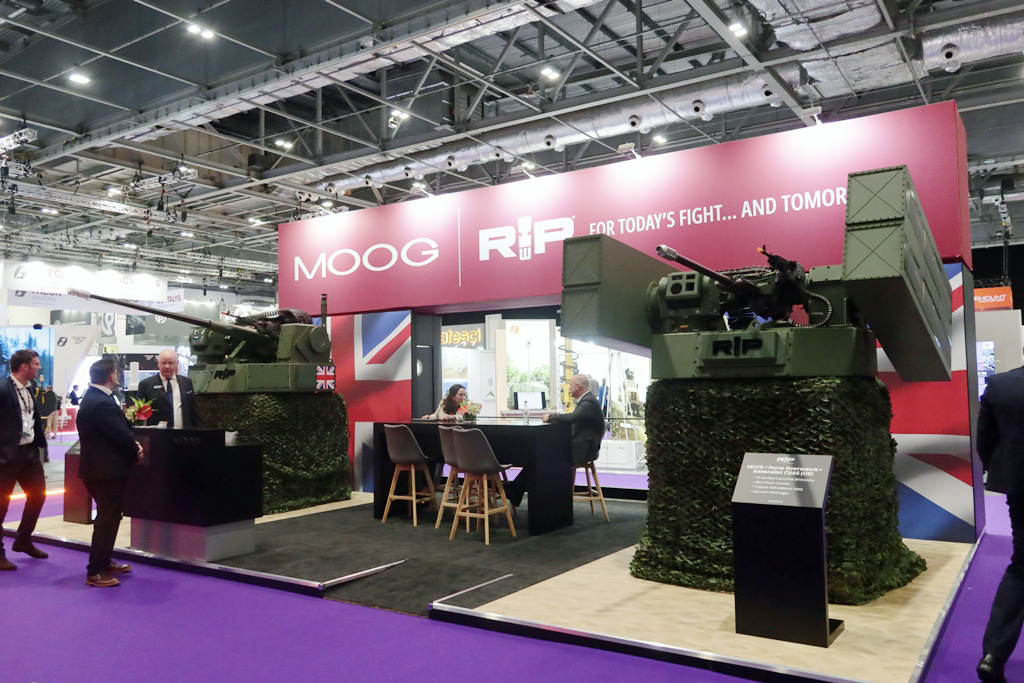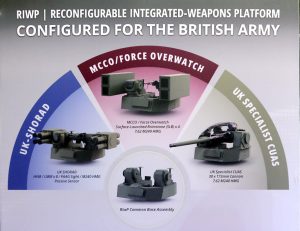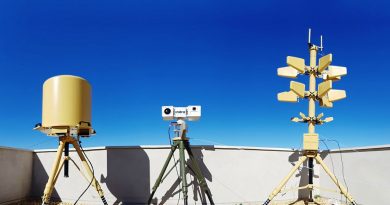
DSEI 2025 – Moog showcases its turret proposals for British Army programmes
At DSEI 2025 Moog, the US turret specialist, presented three configurations of its Reconfigurable Integrated-weapons Platform (RIwP) designed to answer current and future British Army requirements

In the DSEI Land Zone, where several British Army and other vehicles were exhibited, a dedicated Moog stand hosted two configurations of the company RIwP, while a third was visible at short distance, integrated on a General Dynamics Land Systems UK Foxhound 4×4 vehicle.
EDR On-Line dealt with the Moog reconfigurable several times, but as all systems with high modularity, the easy reconfiguration leads to new versions according to evolving customers’ requirements.

Two versions were visible on the company boot. One was designed to answer the Specialist CUAS requirement. It is armed with a 30×173 mm automatic cannon and a coaxial M240 7.62 machine gun, an IFF antenna being visible on the lower front of the turret. As all RIwP-based turret, also in this version the cannon chute, on the right of the system, allows reloading from under armour. Apparently, the current requirement asks only for a medium calibre effector, the turret seen at DSEI being armed with a XM813 dual-feed cannon capable of shooting 30 mm airburst munitions; Moog is however ready to integrate other effectors, such as short-range missiles, should the British Army evolve its requirement.

The second turret visible on the Moog stand was designed to answer the MCCO/Force Overwatch requirement. According to official documents “The Mounted Close Combat Overwatch (MCCO) is a long-range system providing anti-armour coverage to the battle group, with concepts carrying multiple missiles weighing up to 50 kg with a range of up to 10 km or more.” On each side of the turret, we find two MBDA Surface-Launched Brimstone missiles, which container launchers are vertically stacked. The turret structure hosts on the right side the sight while at the centre we find an M240 7.62 mm machine gun, providing some self-defence capability. The MBDA missile is fitted with two seekers, a 94 GHz millimetric wave radar and a semi-active laser seeker, allowing high accuracy, salvo mode and all-weather capability. The tandem shaped-charge warhead was designed to cope with heavy armoured vehicles but can also be used against other types of targets.

Last but not least comes the SHORAD version. On each side of the turret, we find four surface-to-air missiles. These can be of two types, both developed and produced by Thales, the HVM or the LMM. The STARStreak High Velocity Missile (HVM) is a laser beam-riding guidance missile immune to all known countermeasures. With a mass at launch of 14 kg, it flies at over Mach 3 and has an operational range in excess of 7 km. The second missile that can be hosted on this version is the Light Multirole Missile (LMM), also a laser beam-riding missile, it has a 6 km range, and its speed is roughly half that of the HVM.

The SHORAD is also armed with a 30 mm automatic cannon, the Northrop Grumman XM914, which is chambered for the 30×113 mm round. The Thales PAAG (Panoramic Above Armour Gimbal) sight is installed on the right of the turret mount, which includes a high-definition TV, a thermal sight, a short-wave infrared channel, a laser rangefinder, a laser marker, and a laser designator.
Moog underlines that should the British Army select the solutions based on the RIwP, this would allow maximum flexibility as the turrets can be reconfigured at field operational level, should the need arise, in less than half an hour. The system modularity is also key for a rapid and simple update, allowing to adapt the configuration to evolving threats.
Photos by P. Valpolini



